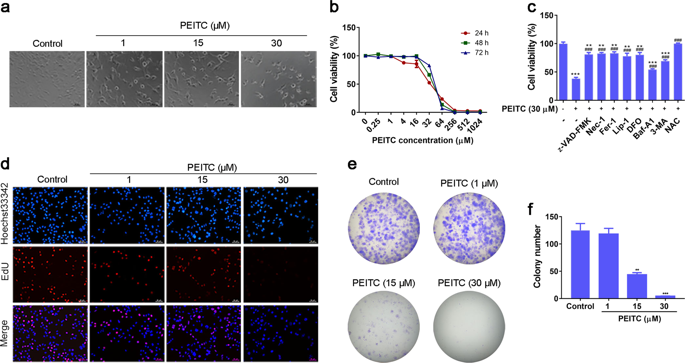Acta Pharmacologica Sinica ( IF 6.9 ) Pub Date : 2020-03-04 , DOI: 10.1038/s41401-020-0376-8 Huan-Huan Lv 1, 2, 3, 4 , Chen-Xiao Zhen 1, 2, 3 , Jun-Yu Liu 1, 2, 3 , Peng Shang 1, 2, 3

|
Phenethyl isothiocyanate (PEITC) is an isothiocyanate that largely exists in cruciferous vegetables and exhibits chemopreventive and chemotherapeutic potential against various cancers. However, it is little known about the molecular mechanisms of its antitumor action against osteosarcoma, which is the second highest cause of cancer-related death in children and adolescents. In this study, we investigated the effects of PEITC on K7M2 murine osteosarcoma both in vitro and in vivo. We found that treatment with PEITC dose-dependently inhibited the viability of K7M2 murine osteosarcoma cells with an IC50 value of 33.49 μM at 24 h. PEITC (1, 15, 30 μM) dose-dependently inhibited the cell proliferation, caused G2/M cell cycle arrest, depleted glutathione (GSH), generated reactive oxygen species (ROS), altered iron metabolism, and triggered multiple forms of cell death, namely ferroptosis, apoptosis, and autophagy in K7M2 cells. We further revealed that PEITC treatment activated MAPK signaling pathway, and ROS generation was a major cause of PEITC-induced cell death. In a syngeneic orthotopic osteosarcoma mouse model, administration of PEITC (30, 60 mg/kg every day, ig, for 24 days) significantly inhibited the tumor growth, but higher dose of PEITC (90 mg/kg every day) compromised its anti-osteosarcoma effect. Histological examination showed that multiple cell death processes were initiated, iron metabolism was altered and MAPK signaling pathway was activated in the tumor tissues. In conclusion, we demonstrate that PEITC induces ferroptosis, autophagy, and apoptosis in K7M2 osteosarcoma cells by activating the ROS-related MAPK signaling pathway. PEITC has promising anti-osteosarcoma activity. This study sheds light on the redox signaling-based chemotherapeutics for cancers.
中文翻译:

PEITC 通过 K7M2 鼠骨肉瘤细胞中 GSH-铁-ROS 调节触发多种形式的细胞死亡。
异硫氰酸苯乙酯(PEITC)是一种异硫氰酸酯,主要存在于十字花科蔬菜中,对多种癌症具有化学预防和化疗潜力。然而,人们对其抗骨肉瘤的分子机制知之甚少,骨肉瘤是儿童和青少年癌症相关死亡的第二大原因。在本研究中,我们在体外和体内研究了 PEITC 对 K7M2 小鼠骨肉瘤的影响。我们发现,PEITC 治疗剂量依赖性地抑制 K7M2 鼠骨肉瘤细胞的活力,24 小时时的 IC 50值为 33.49 μM。 PEITC (1, 15, 30 μM) 剂量依赖性地抑制细胞增殖,导致 G 2 /M 细胞周期停滞,耗尽谷胱甘肽 (GSH),产生活性氧 (ROS),改变铁代谢,并引发多种形式的细胞K7M2 细胞中的死亡,即铁死亡、细胞凋亡和自噬。我们进一步发现,PEITC 处理激活了 MAPK 信号通路,ROS 的产生是 PEITC 诱导细胞死亡的主要原因。在同基因原位骨肉瘤小鼠模型中,给予 PEITC(每天 30、60 mg/kg,ig,持续 24 天)显着抑制肿瘤生长,但较高剂量的 PEITC(每天 90 mg/kg)会损害其抗肿瘤作用。骨肉瘤作用。组织学检查显示肿瘤组织中启动了多个细胞死亡过程,铁代谢发生改变,MAPK信号通路被激活。总之,我们证明 PEITC 通过激活 ROS 相关的 MAPK 信号通路诱导 K7M2 骨肉瘤细胞铁死亡、自噬和凋亡。 PEITC 具有良好的抗骨肉瘤活性。 这项研究揭示了基于氧化还原信号的癌症化疗药物。











































 京公网安备 11010802027423号
京公网安备 11010802027423号